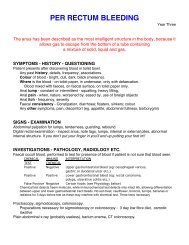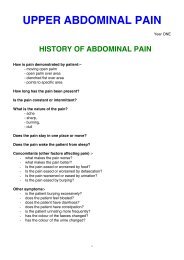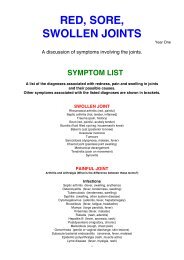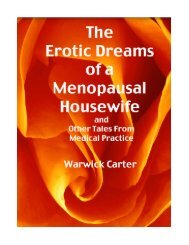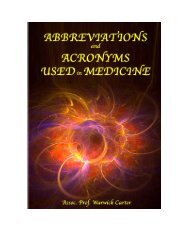Menopause A to Z.pdf - Medwords.com.au
Menopause A to Z.pdf - Medwords.com.au
Menopause A to Z.pdf - Medwords.com.au
You also want an ePaper? Increase the reach of your titles
YUMPU automatically turns print PDFs into web optimized ePapers that Google loves.
MENOPAUSE A <strong>to</strong> Z<br />
A TO Z<br />
ACNE<br />
Acne, spots, pimples, zits. It doesn’t matter what they are called, nobody likes <strong>to</strong> have them, or look at them. Acne<br />
can vary from the annual spot, <strong>to</strong> a severe disease that may c<strong>au</strong>se both skin and psychological scarring. It is generally<br />
a curse of teenage years, but it may strike later in life <strong>to</strong>o, particularly in women. Acne is usually more severe in<br />
teenage males, but starts earlier in females. Acne affects C<strong>au</strong>casians (whites) more than Negroes or Chinese races.<br />
The face, upper chest, upper back and neck are most <strong>com</strong>monly affected.<br />
Pimples are due <strong>to</strong> a blockage in the outflow of oil (known as sebum) from the thousands of tiny oil glands in the<br />
skin. This blockage can in turn be c<strong>au</strong>sed by dirt (un<strong>com</strong>mon in our super-clean society), dead skin left behind during<br />
the normal regular regeneration of the skin surface, or a thickening and excess production of the oil itself.<br />
Once the opening of the oil duct be<strong>com</strong>es blocked, the gland be<strong>com</strong>es dilated with the thick oil, then inflamed, and<br />
eventually infected. The result is a white head, with the surrounding red area of infection. Eventually this bursts,<br />
sometimes leaving a scar.<br />
The most <strong>com</strong>mon c<strong>au</strong>se of acne is the thickening of sebum c<strong>au</strong>sed by the hormonal changes of puberty. The<br />
severity of acne in a teenager will depend upon the degree of acne suffered by his/her parents, as this is a strongly<br />
inherited characteristic. Pregnancy, premenstrual syndrome (hormonal changes before a period), menop<strong>au</strong>se and the<br />
oral contraceptive pill may all c<strong>au</strong>se pimples in this way.<br />
Stress in the patient, either psychological or c<strong>au</strong>sed by disease, may make pimples worsen. A simple cold, or the<br />
onset of exams may see the number of spots increase dramatically.<br />
If the onset of acne is after the teenage years, or recurs, the polycyctic ovarian syndrome may be responsible, and<br />
medications such as the contraceptive pill and metformin may be helpful.<br />
Pressure from spectacles on the bridge of the nose or tight collars, increases in skin humidity from a fringe of hair or<br />
nylon clothing, and excessive use of cosmetics that<br />
further block the oil duct openings, can all c<strong>au</strong>se<br />
deterioration in a person’s acne. Some chemicals or<br />
oils that a patient may encounter in the work place are<br />
also possible c<strong>au</strong>ses. Medications such as pheny<strong>to</strong>in,<br />
lithium, isoniazid, rifampicin may also be responsible.<br />
Treatment of asthma or other diseases with<br />
steroids (eg. prednisone) may worsen acne. A tumour<br />
of the pituitary gland under the brain, or the adrenal<br />
glands on each kidney, may produce higher than<br />
normal levels of steroids <strong>to</strong> mimic this problem.<br />
The severity of acne also depends on hereditary<br />
fac<strong>to</strong>rs. There is no evidence that dark chocolate,<br />
vitamins or herbs have any effect on acne, but there is<br />
some new evidence that a diet high is sugar and foods<br />
with a high glycaemic index may aggravate acne.<br />
A number of conditions can c<strong>au</strong>se a rash that looks like acne, but is not. The most <strong>com</strong>mon of these are rosacea<br />
and folliculitis barbae (ingrown facial hairs c<strong>au</strong>sed by blunt blade when shaving or other skin damage). Rosacea is a<br />
skin disease of the face, found most <strong>com</strong>monly in middle-aged women, that c<strong>au</strong>ses excessive intermittent flushing of<br />
the face, then sores develop that are similar <strong>to</strong> a severe case of pimples.<br />
There is no evidence that diet, vitamins or other herbs have any effect on pimples. A small number of sufferers may<br />
find that one particular food c<strong>au</strong>ses a fresh crop of spots, but these people usually quickly realise this and avoid the<br />
offending substance.<br />
The first step in treatment involves keeping the skin clean with a mild soap and face cloth, and simple oil drying,<br />
antiseptic and cleansing creams or lotions. Further treatment involves <strong>com</strong>binations of antibiotics (eg. tetracyclines)<br />
that may be taken in the short term for acute flare ups or in the long term <strong>to</strong> prevent acne, skin lotions or creams<br />
containing antibiotics and/or steroids, and changing a woman's hormonal balance by putting her on the oral<br />
contraceptive pill or using other hormones. In rare cases it is necessary <strong>to</strong> take the very potent medication isotretinoin<br />
(which can c<strong>au</strong>se birth deformities if used during pregnancy), give steroid injections (eg. triamcinolone) in<strong>to</strong> the skin<br />
around particularly bad eruptions, and abrade away the skin around scars. The treatment of adults with maturity onset<br />
acne is more difficult than juvenile acne.<br />
Acne may c<strong>au</strong>se both skin and psychological scarring. Picking acne spots can c<strong>au</strong>se serious secondary bacterial<br />
infections that can spread deep in<strong>to</strong> the skin (cellulitis).<br />
Although acne cannot be cured, in the majority of cases reasonable control can be achieved.<br />
5




